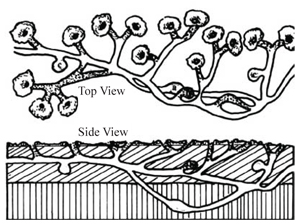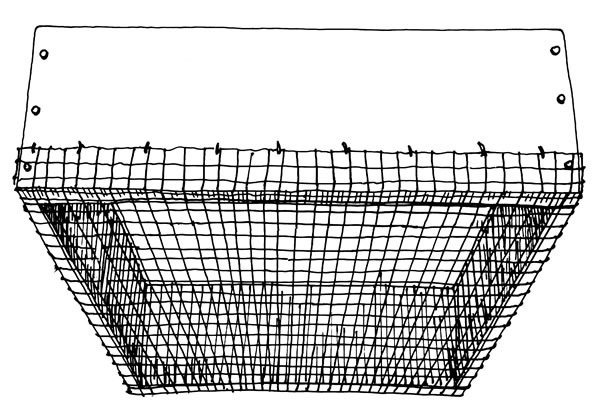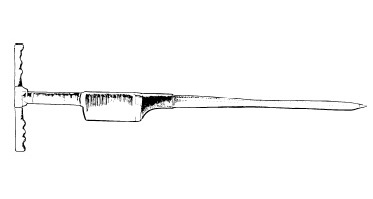 Managing Pocket Gophers, Part 2 - November 9, 2016 Jeff Schalau, Agent, Agriculture & Natural Resources University of Arizona Cooperative Extension, Yavapai County Last week’s Backyard Gardener column discussed pocket gopher biology and how to use lethal traps as a tool to manage them. Successful trapping is only the beginning for gardeners that have a long history of gopher activity. This week’s column adds additional management strategies and addresses some of the gopher management myths. Exclusion is one strategy used to mitigate pocket gopher damage to young plants, raised beds, and small garden plots. Metal fencing material is sometimes buried around the perimeter of small garden spaces. Galvanized metal hardware cloth (1/4-inch or 1/2-inch) can be buried 18 inches deep around garden fences. Some gophers will dig deeper than this, but it will probably be dependable about 90% of the time. Gophers also travel above ground but are not likely to climb higher than one foot over a fence. Placing hardware cloth in the bottom of constructed raised beds is also very effective as long as the gophers cannot climb over the sides of the bed. Hexagonal poultry wire is often used to create wire baskets that are installed at planting to protect the roots of young woody plants such as fruit trees. Poultry wire with the smallest openings (one-inch) should be used. There are some caveats with this approach. First, remember that gophers travel above ground and can simply walk over the basket if it does not extend above ground for a foot or so. Also, roots can easily grow beyond the cage and become vulnerable to gopher feeding. In addition, the wire could stunt the plant due to root girdling (disruption of secondary phloem under the bark) as the roots grow in diameter where they go through the wire basket. After several years in the ground, the wire may start to disintegrate before serious root girdling occurs. Flood irrigation, as is often used along the ditch systems of the Verde and its tributaries, can also go far to discourage gopher colonization. Upon flooding, the gopher will flee its burrow system making it vulnerable to predators. In the flood irrigated areas of the Verde Valley, Great Blue Herons are common gopher predators. Flooding burrow systems with a garden hose is impractical except when the goal is to collapse or expose the burrow system. A single burrow system may contain up to 200 yards of tunnels (see graphic below). Established burrow systems allow nearby gophers to easily repopulate a given area. Burrow systems can be obliterated by tilling or collapsing with water as noted above. For large areas, landowners may consider deep tilling a perimeter that can be monitored for gopher activity rather than trying to deep till the entire acreage. Toxicants (poisons) and bait placement devices can be purchased from farm and forestry suppliers. For small properties, I do not recommend using toxicants to manage pocket gophers. These toxicants can be inadvertently consumed by pets or other non-target animals or cause secondary poisoning to animals consuming a gopher that consumed a toxicant. For larger acreages, a landowner may want to consider toxicants as part of an integrated gopher management program. Gaseous toxicants are variable in their effectiveness against pocket gophers. The small “gopher smoke bombs” have not been effective in my experience. Connecting metal tubing to the exhaust pipe of an older vehicle or tractor may also have poor to marginal results. Gophers can sense air movement and easily wall off sections of the burrow to prevent the gas from reaching them. There are also devices that fill the burrow with an oxygen/propane mixture and when sparked, delivers a concussive blast. If experimenting with these methods, it is incumbent on the user to do so safely and without starting a fire. Various repellents, commercially available as well as home remedies, are often considered for use because they seem more humane or pose a lower risk to non-target organisms. Predator odors such as urine and feces may be somewhat effective, but will need to be constantly reapplied as they dissipate with time and as the burrow system becomes larger. Electronic devices, little windmills and other scare tactics have been proven to be ineffective. Plants such as gopher purge (Euphorbia lathyrus) and castor oil plant (Ricinus communis) have similarly proven ineffective. Lastly, we have the “home remedy” repellents that you hear about in various non-research based publications and websites. These include: loud radios, human hair, Juicy Fruit gum, Irish Spring soap, chocolate flavored Ex-Lax, and others. These are all ineffective as pocket gopher repellents or toxicants. Follow the Backyard Gardener on Twitter – use the link on the BYG website. If you have other gardening questions, call the Master Gardener help line in the Camp Verde office at 928-554-8992 or e-mail us at verdevalleymg@gmail.com and be sure to include your name, address and phone number. Find past Backyard Gardener columns or provide feedback at the Backyard Gardener web site: http://cals.arizona.edu/yavapai/anr/hort/byg/. Graphics  Graphic depiction of an excavated pocket gopher burrow system.  Hardware cloth on the bottom of raised beds can be very effective. However, you must build the sides tall enough to prevent climbing over (18" plus). Gophers have also been known to climb overhanging plants to gain access to a bed.  Pocket gopher bait placement probe. This tool has a chamber which is filled with a toxicant and allows direct placement in the burrow system. |